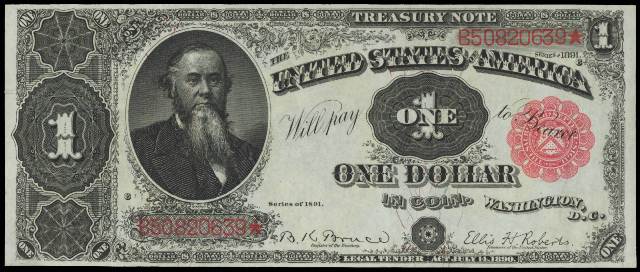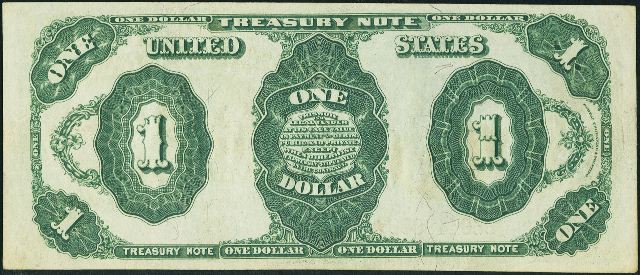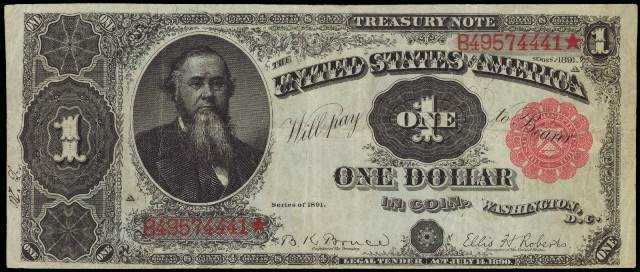Series of 1891 $1 Treasury Note Values
History: Treasury notes were only printed in 1890 and 1891. Some notes in the 1860s did say “treasury note” on them. However, those are not true treasury notes. Our guide here is specifically looking at the series of 1891 $1 treasury note. These are also sometimes called 1891 $1 coin notes. 1890 and 1891 $1 treasury notes look very similar at first glance. However, there are differences in the seal type and color. The 1890 $1 treasury note also has a very dark green back. The back of the 1891 $1 specimen has a lot more white space. For the record, 1890 specimens are definitely rarer and more valuable. All notes from 1891 have a rounded red seal and red serial numbers.
Nickname: Like many large size currency notes from the late 1800s, the series of 1891 $1 treasury note has taken on a nickname based on the person featured on it. Many collectors simply call this a “Stanton” note. Edwin M Stanton is the bearded man on the left hand side of the bill. If talking currency lingo just remember to say 1891 Stanton. You don’t want people to confuse it with the earlier and rarer issue from 1890 that also features Stanton.
Other Facts: The biggest misconception about 1891 $1 bills is that they are star notes. Yes, every serial number does end with a solid red star. However, that does not signify that they are star replacement notes. The Bruce Roberts signature combination was only used in 1898; that is the least year that 1891 $1 bills were printed. Replacement star notes were not incorporated until 1910. Replacement stars are also hollow, not solid. So the star at the end of your serial number does not add any value. They are all like that. The star is just a design element.
Values and Grading: Prices for series of 1891 $1 treasury notes range from as little as $20 to about $2,000. The note itself is very common. There are three different signature combinations for this issue. Your 1891 $1 bill could be signed by Rosecrans and Nebeker, Tillman and Morgan, or Bruce and Roberts. Each signature combination is equally common. There really aren’t any special varieties. The value all comes down to condition. Our grading guide below shows you how to price notes in different conditions. Do remember that a serial number under 100 is worth more money than a standard serial number.
Choice Uncirculated or Better: There are hundreds of high grade uncirculated 1891 $1 treasury notes known to exist. Many of them are from a handful of different runs of consecutively serial numbered notes. You can buy notes in the grades of 63 to 66 with easy. It is much more difficult to find items that are 67s and 68s. However, some of them are out there. Any UNC note should be in perfect condition. That means no folds and virtually no handling. It should literally look like it was printed this morning. The details, embossing, color, and paper wave should all be absolutely perfect. Prices start at about $1,000 and go up from there based on centering.

This Beautiful 1891 $1 Treasury Note Is Worth About $1,500
Extremely Fine to About Uncirculated: Most collectors know that if you want a high quality bank note with all the eye appeal of an uncirculated note for about 80% of the price then you should buy something in the XF 40 or 45 range. The note we have pictured graded as a 40. We really can’t see any distractions or imperfections. Odds are that the note does have two or three lights folds. Once put into a third party holder it becomes very difficult to tell the difference. There is not a huge supply of 1891 $1 treasury notes in this grade. We see lots of uncirculated notes and lots of notes in poor condition. However, high quality 1891 $1 bills in XF and AU condition are closely held. Prices range from about $500 to $1,000.

An 1891 $1 Bill In XF Condition Can Occasionally Look Perfect Like This Example
Fine to Very Fine: There are a lot of really attractive 1891 $1 treasury notes out there. The note we have pictured graded a very fine 25 out of 70. You can see lots of fold lines. However, it is in really nice condition for the grade. The paper looks really strong and somewhat crispy. The red inks are very lightly faded. Obviously a Fine 12 would be a little bit worse and a very fine 35 will look nicer. However, no matter the grade range between 12 and 35, all notes should be attractive and absent of major condition issues. Most collectors describe this grade as lightly circulated. Prices range from about $125 to $400.

It’s Too Bad All 1891 $1 Treasury Notes In Circulated Condition Don’t Look This Nice
Very Good and Lower: We have included a very rough looking 1891 $1 treasury note. It almost looks like the margins have been burnt out a little bit. Surprisingly though, they can come much worse than this. We often see tape, tears, rust, stains, missing pieces, writing, etc. If it is bad and it can affect paper money, then this grade range could have it. Most 1891 $1 bills in this price range sell for around $20 to $75. The people buying these are mostly hole fillers and impulse buyers. Advanced collectors will have no interest in something this low grade.

The Age And Circulation Is Painfully Present On This 1891 $1 Stanton Note
Need an Appraisal or Offer? We appraise and buy series of 1891 $1 treasury notes. If you would like to receive a free appraisal and offer on your bill then just send us pictures of what you have. We will respond quickly with our best price. Sales@AntiqueMoney.com


